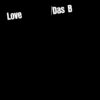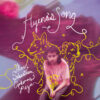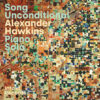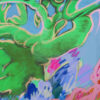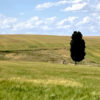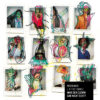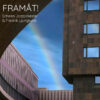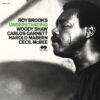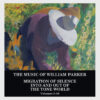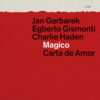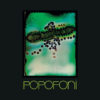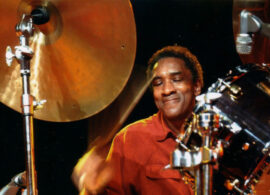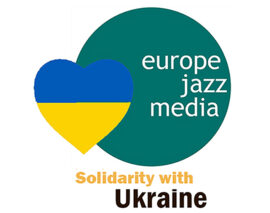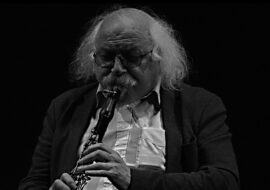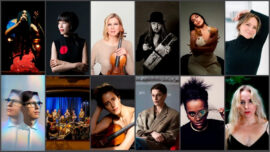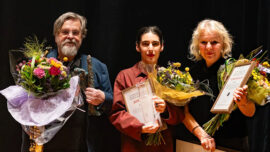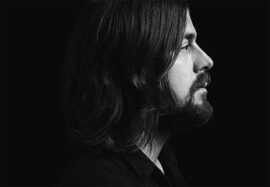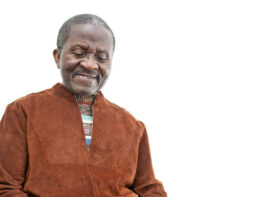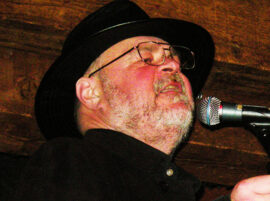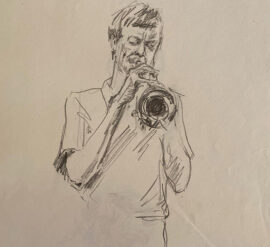AURA – WHEN MILES CONQUERED COPENHAGEN – Salonen, København Hovedbibliotek: Saturday, February 14, 2015
As we have already noted here at salt peanuts* we have just celebrated the thirtieth anniversary of the live performance and recording of the suite «Aura», see the article here. The Danish composer and trumpeter Palle Mikkelborg wrote the suite for the award ceremony of the Leonie Sonning Music Prize 1984. 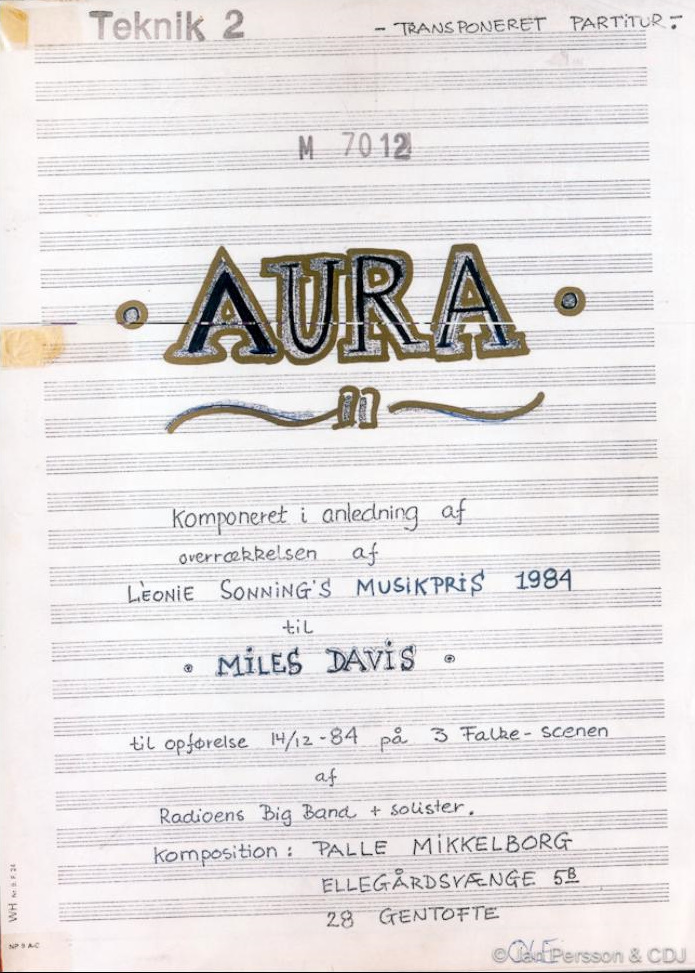 This year the prize was awarded to the Black Prince himself – to Miles Davis on December 14, 1984 at the venue of 3 Folke scenen at Falkoner Teatret in Copenhagen.
This year the prize was awarded to the Black Prince himself – to Miles Davis on December 14, 1984 at the venue of 3 Folke scenen at Falkoner Teatret in Copenhagen.
Saturday 14th of February 2015 we – that is, the editorial management board of salt peanuts* – were in Copenhagen. We were assembled to discuss the future plans of this pan-Nordic platform for presentation and debate on Nordic jazz. But not just that.
We chose this particular date because it coincided with a key event at the Copenhagen City Library, organized by one of our senior writers, Niels Christensen. Christensen had invited Palle Mikkelborg and Marilyn Mazur for a presentation of ideas and memories of their time and collaboration with Miles Davis starting with the performance, and a month and a half later, the recording of Mikkelborg’s suite.
In the eye of the future historian the date will not – unfortunately – be remembered for the seminar at the City Library. This day Copenhagen changed character as a lunatic with an automatic gun decided that a particular event, the key message of which was that freedom of expression is a vital part of what makes a democratic society, was an obvious target for making an abhorrent statement. At the end of it the terrorist killed two individuals and wounded several other, turning February 14, 2015 into a date with a very different colour of the one we intended to give it.
But fortunately this was in the future when we were sitting down in the «Salonen» of Hovedbiblioteket of Copenhagen. To meet Mikkelborg and Mazur and their impressions of their meeting with Miles. The seminar’s title was «AURA: When Miles Davis conquered Copenhagen – Meet Mazur & Mikkelborg».
 As our readers know by now, Mikkelborg was hired to write a suite, to be performed during the award ceremony. The hope was that Miles Davis would contribute for a few minutes on the suite. But he contributed much more than that. With an expanded version of the Danish Radio Big Band, Davis gave an extensive contribution, And in the end he further prolonged the prize ceremony on this December night in 1984 with a set of three extensive encores, including «Time after Time» and «Jean-Pierre».
As our readers know by now, Mikkelborg was hired to write a suite, to be performed during the award ceremony. The hope was that Miles Davis would contribute for a few minutes on the suite. But he contributed much more than that. With an expanded version of the Danish Radio Big Band, Davis gave an extensive contribution, And in the end he further prolonged the prize ceremony on this December night in 1984 with a set of three extensive encores, including «Time after Time» and «Jean-Pierre».
The first part of the seminar the early afternoon on this Saturday was a conversation of Mikkelborg and Christensen of the process that eventually led to «Aura» being published by Columbia in 1989. Palle Mikkelborg’s reminiscences are summarised here.
It’s not about the money!
The Leonie Sonning Prize had never been awarded to a jazz musician before. However, in 1984 they appointed Miles Davis as the recipient of that year’s prize. The organization behind the Leonie Sonning Award sent bassist and jazz producer/organizer Erik Moseholm to New York to inform Miles Davis about the appointment. Erik Moseholm arrived in New York and finally managed to get in contact with Miles.
On the breaking of the news Miles’ reaction was disappointing – even if the award itself might be unknown in the US, it was still an award involving a prize of around 100 000 Danish «kroner», or around US 2015-$ 35 000 . But Miles was far from impressed. However, when Erik Moseholm could explain that this was the first time the Leonie Sonning Prize was awarded to a jazz musician, and the former recipients included Igor Stravinskij and Leonard Bernstein, his attitude changed.
Give me my money, motherf….!
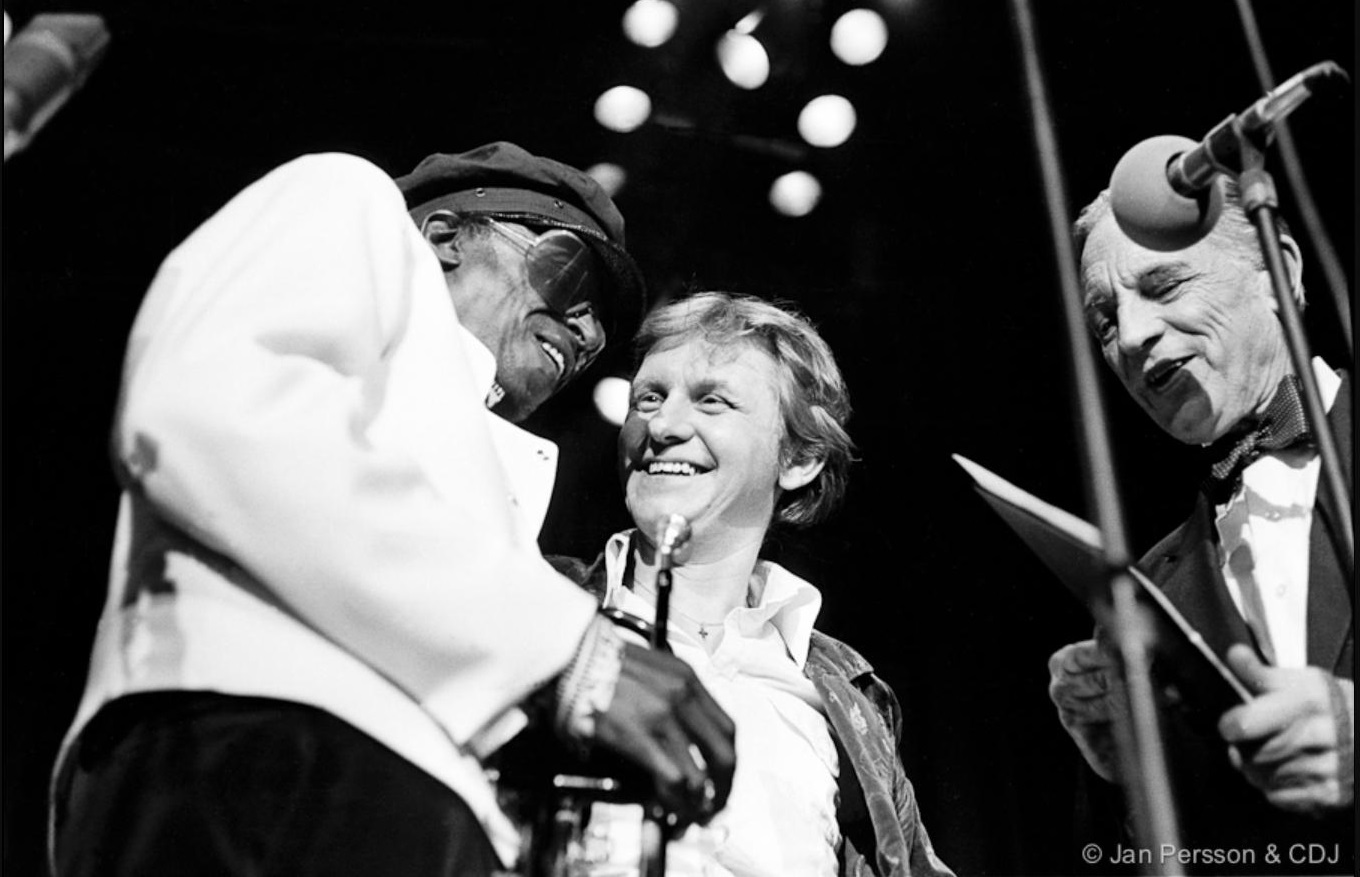 The Leonie Sonning Award was – even as late as 1984 – part of a «serious art music» system where dress code meant black suit and conservative white shirts with ties. However, Miles Davis was never the conformist when it came to behaviour and dressing code. Miles broke every rule in the book with his attire that night. As did Palle and the band. To illustrate, previous laureates included Dmitrij Sjostakovitsj, Yehudi Menuhin and Mstislav Rostropovitsj. The 1985 recipient of the prize would be Pierre Boulez.
The Leonie Sonning Award was – even as late as 1984 – part of a «serious art music» system where dress code meant black suit and conservative white shirts with ties. However, Miles Davis was never the conformist when it came to behaviour and dressing code. Miles broke every rule in the book with his attire that night. As did Palle and the band. To illustrate, previous laureates included Dmitrij Sjostakovitsj, Yehudi Menuhin and Mstislav Rostropovitsj. The 1985 recipient of the prize would be Pierre Boulez.
December 14., 1984 the ceremony started at the 3 Falke (= 3 Falcons) stage of the Falkonér Theatre at 3 pm. After the performance of Ray Pitts’ commissioned work «Beyond Logic», the audience could – during the intermission – walk around and watch the twenty oil paintings of Miles Davis that were shown.
While they walked back into the concert hall, a tape was playing in the background. It played some abstract music Palle Mikkelborg had created to acquaint the audience with «a certain sound and a certain scale when they came into the hall». Palle Mikkelborg and the band started to play Mikkelborg’s commission – the suite he had called «Aura». The performance started out by a haunting sounding oboe solo by Niels Eje over Mikkelborg’s soundscapes. From there the movements segued into each other. The performance lasted for well over an hour, during which John Scofield and Miles Davis joined the band.
While the first encore – a repeat of the last movement «Violet» – was still sounding, a nervous young man came out on the stage with the almost DKK 100 000 cheque in his hand, while the band still played Mikkelborg’s music. Miles started circulating the young man – horn in hand – and seemed to think that things were going a bit slow.
After having checked the guy out for some time, with him getting even more nervous about what to do, Miles says to him in his rasping voice, «Give me my money, motherfucker»! It is easy to imagine what this did to the already shit nervous guy. But as Palle Mikkelborg replied after having told the story, «they later became good friends».
Listening to the tape of the broadcast from the ceremony, you can hear the nervousness of the awarding representative of the Leonie Sonning Foundation, Børge Friis. He almost stumbles in his Danished English, awarding the prize «in the field of folk music»! He starts talking to a dead microphone, when he asks the audience and Miles in English «Do you understand me?». I hope he was so nervous that he never really registered Miles’ comment.
The Zen master: I prefer peace
Some time mid-January Palle Mikkelborg got a telephone call in the middle of the night. A rasping voice at the other end said;
– We’ll do the recording. Get the band together – I’m coming at the end of the month.
Mikkelborg – drowsy – thought it was the bassist Bo Stief, a wellknown prankster, putting him on. So he answered the caller back in Danish,
– Shut the f… up! It’s the middle of night, Bo! From the other end of the line came the reply, – WHAT?!?
But it was of course Miles on the line, calling from New York. In the end, Mikkelborg caught on to who it was at the other end.
On short notice he had to call the musicians and the DR Big Band back from an ongoing tour, to get everything ready for the recording sessions two weeks later. Miles and the band arrived on time.
In the studio during the recording in early February 1985 of «Aura», the trumpet section included the then 24 years old Jens Winther, Danish jazz musician and composer. At one point he approached Miles to show him his trumpet, a particular specimen he was proud of.
– Miles, said Jens Winther, I’d like you to see my trumpet. – It looks great, Miles replied.
– It’s from before the war!, Winther explained, meaning WWII.
Miles looked up at him and quipped, – I prefer peace!
Palle Mikkelborg emphasized the role Miles played in the Easy Sound Studio, creating a friendly and equitable atmosphere.
– When he came in, all the musicians were very tense. He walked around, and it calmed everyone down. Miles was good at getting those around him to feel comfortable.
In discussing the compositions, Mikkelborg was clear about how Miles shaped the recorded suite, how he uncovered the essence of the expression. Mikkelborg described one instance where Miles had pointed to a certain part of the scores, saying;
– I like saxophones, but not in groups. Take these sections out!
In hindsight, Mikkelborg said to us, it definitely improved the composition. He then told us how he had said to Miles at one point,
– You are like a Zen master to me. Miles replied with the question: – What do you mean?,
to which Palle Mikkelborg replied,
– I haven’t got a clue of what you mean – but I know you’re right!
Miles Davis referred to this later in his autobiography, so as Palle told us,
– I had at least some influence on him!
The «White» story
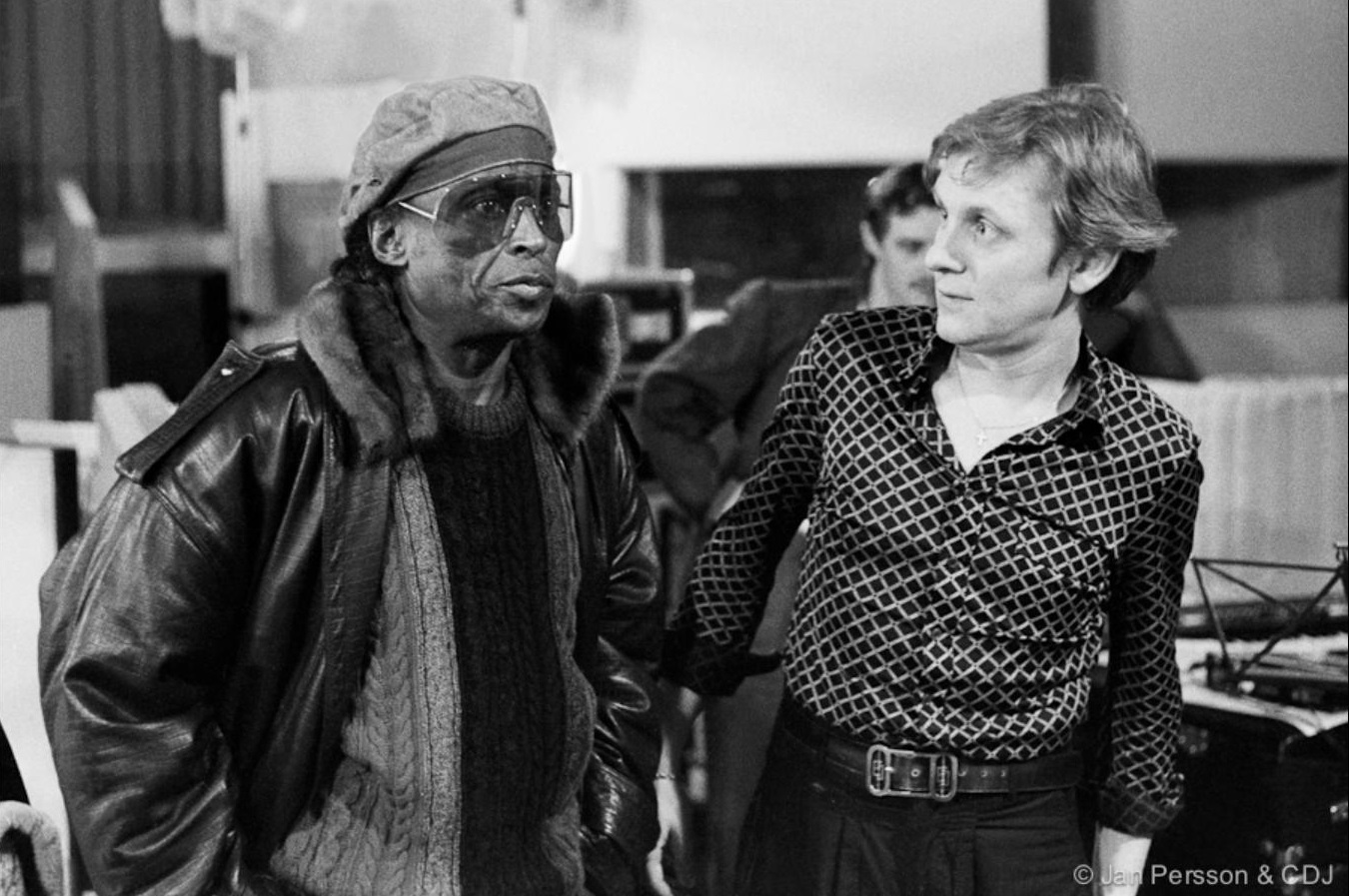 In physics white noise is the full sound when all frequencies across the whole spectrum have the same amplitude – it is the quintessential expression of noise, sound without any structure. The movement «White» on the «Aura»-record is anything but white noise. An etheral ten-note line from Miles’ muted trumpet opens up, over a slowly moving soundscape created by Mikkelborg. Niels Eje plays the theme on oboe, while Marilyn Mazur creates an environment that moves along with the music.
In physics white noise is the full sound when all frequencies across the whole spectrum have the same amplitude – it is the quintessential expression of noise, sound without any structure. The movement «White» on the «Aura»-record is anything but white noise. An etheral ten-note line from Miles’ muted trumpet opens up, over a slowly moving soundscape created by Mikkelborg. Niels Eje plays the theme on oboe, while Marilyn Mazur creates an environment that moves along with the music.
The soundscapes of Mikkelborg were pre-recorded, and not intended to be included in the suite. But just as white noise, white light contains all wavelengths – all colours. All these colours are what you get when you shine the white light onto a transparent glass prism. White is what you need to generate all the colours of the rainbow, which are all reflected in the names of the suite’s movements. As the movement «White» is the mother of all the other movements. Just as music, physics is also beauty!
White light is the origin of all the colours – the origin of life. That is how I read the presence of the first movement after the ouverture «Intro». It is the seedling of the suite.
The reality is slightly more mundane – but only slightly so. As indicated above the movement takes its name from the white of the light before it is diffracted into the beautiful colours of the rainbow. It has its origin in the background tape played during the intermission during the ceremony.
Towards the end of the recording sessions in the Easy Sounds studio, almost everyone had left. Left were Miles, Palle, Niels Eje and Marilyn Mazur. Following a long period of silence, Miles suddenly asked Mikkelborg:
– Do you have that tape? Mikkelborg answered back, – Which tape?
He quickly realized what tape Miles meant. The pre-recorded tape that had been played at the concert. Luckily, one of the engineers at the session had a reel with a 7 ½-speed copy of that music.
No preparation, they just jumped at it. Miles played over the tape, Mikkelborg told Eje that «when I do this, you start playing the theme – when I do like this, you stop.» To Mazur the message was simple, «do whatever you want!»
After we had listened to the track thirty years later, Mikkelborg told us that
– It was magical! A moment of serenity. Miles was sitting in the dark, contemplating what had happened. Then he looked up at me, smiled and said. ‘Did you like my rhumba?’
M & M – Miles and Marilyn
This was the first time Marilyn Mazur and Miles Davis met. As she told us at the seminar it wouldn’t take long before she met him again. Half a year later, during the Moldejazz festival of 1985, they met again. Marilyn was adamant to get to see Miles’ concert at the festival, in spite of her late arrival in Molde.
The concert was packed – completely sold out. Marilyn and her companions were lucky enough to get seated on the floor in front of the first row at the venue of Idrettens hus.
A bit into the concert Miles recognized Mazur in front of the stage and waved to her – come on up. Join us! As Marilyn was feeling a bit under the weather, she declined the invitation. But Miles was insistent and repeated the invitation a bit later, beckoning her up on the stage.
As she said at the seminar, – who was I to say no to Miles when he had asked twice?
That’s why she is there on the tape of the broadcast from that evening July 24, 1985 in Molde.
A month or so later Mazur got a telephone call from New York on a Sunday. – Come over here and play with us on Wednesday.
This time Marilyn complied on the first request and joined the band. She explained;
– This was the first time I was in New York – the town in which I was born – since I was a kid. After my parents moved to Denmark and had brought me with them, going back was not an option – up till now.
– I played with Miles for a year, travelling all over the world. Even though I moved to New York, I didn’t feel at home.
The band she was playing in, was the band with Bob Berg and others. Here she shared the percussion slot in the band with Steve Thornton. After a while and with some frustration she asked Thornton if they could talk over how they coordinated and shared the percussion, to which Steve Thornton replied,
– You don’t tell me how I should play, and the I won’t tell you what to play. OK?
And that was it. After a year she left the band and returned to Denmark.
Two years later – in 1988 – Miles called her again. He was reorganizing his band, this time with the young Kenny Garrett on saxophones, Robert Irving III and Adam Holzman on keyboards, and Mazur as a sole percussionist, besides the drummer Ricky Wellman. This time she suggested she was more at ease with the band and the other musicians;
– While the first band was together on the stage only, the musicians of the second band were hanging out together, having fun together.
Marilyn Mazur left Miles’ band at the end of 1988. One of her last concerts with Miles was in Bergen, Norway in October 1988.
Text: Johan Hauknes
Photos: Jan Granlie (colour image) & The Jan Persson Jazz Collection of the Center for Danish Jazz History at Aalborg University. All copyright for the B&W images belongs to Jan Persson and the Center for Danish Jazz History. See the janperssoncollection.dk for more photos from the concert and recording sessions. We are grateful for the permission to use these images.

